Aparna of My Diverse Kitchen was our August 2013 Daring Bakers’ hostess and she challenged us to make some amazing regional Indian desserts. The Mawa Cake, the Bolinhas de Coco cookies and the Masala cookies – beautifully spiced and delicious!
A light cardamon and vanilla scent spread through the house when I cooked the Mawa cake. We were lucky enough to be able to try this cake while it was still slightly warm, which I think made it ever so more tantalising. A beautifully textured cake, it was lovely and moist with a beautiful flavour.
Although the cake itself was as easy to make as any butter cake, the mawa was a bit time consuming. I didn’t think this would be an issue as I was making the base for the bolinhas de coco at the same time, so I was able to keep an eye on the milk and stir it often. Even with my non-stick saucepan the bottom seemed to stick and burn a little, so when it really started to reduce I transferred it to another saucepan. It did reduce down to a very interesting paste, despite my concerns about it burning. I would never have thought to cook milk for 2 hours and reduce it like this recipe states.
Would I like to eat this cake again – of course, although maybe if there was an easier way to make the mawa 🙂
The next recipe I tried was the bolinhas de coco, a biscuit made with coconut, semolina and cardamon flavour. I used up one coconut (which made about 2 1/2 -3 cups coconut flesh), and got Nick to remove all the flesh from the shell, then put it straight into the food processor. I then made the base for the biscuits, which was the semolina, coconut and sugar syrup. This mix tasted lovely by itself, so I was excited to cook the biscuits the next night. I found it difficult to break up this base the next night, and mix the base with the eggs and cardamon.
I found the biscuits a bit hard to roll up, the mix was quite sticky, and in hindsight I should have used flour (as suggested) to help with the rolling. This also made my biscuits not as beautiful as Aparna’s ones. The biscuits had a lovely crunchy outside and soft chewy inside, with a light cardamon flavour. (although the next day they had lost this lovely crunch).
I wish I had the chance to make the Masala biscuits, they sounded lovely with different spices. Sunday was just too lovely to spend all day inside, as we are having beautiful Spring days even before Winter finishes – time to make the most of these days.
MAWA CAKE (Cardamom Flavoured Milk Cake)
Servings: Serves 8 to 10
Mawa Cakes are a specialty cake that is the hallmark of Irani cafés in India. The Iranis are Zoroastrians who left Persia/ Iran in the 19th and early 20th centuries to escape persecution of non-Muslims, and settled down and thrived here mostly in the cities of Mumbai, Hyderabad and Pune. They’re most famous in India for their friendly informal cafés/ restaurants that serve the most awesome food. The brun pav or maska pav(kinds of bread) with Irani chai (thick, strong, sweet and milky cardamom flavoured tea), their Shrewsbury biscuits and Mawa cakes are just a few of them.
Mawa (also known as Khoya/ Khoa) is made by slowly reducing milk (usually full-fat) until all that remain is a mass of slightly caramelized granular dough-like milk solids. Mawa is used in a wide variety of Indian sweets like Gulab Jamun and Peda, to mention just two. Mawa is pronounced as Maa-vaa; Khoya is pronounced as KhOh-yaa.
In this cake, Mawa lends a rich and a caramelized milky taste to this cake which is slightly dense and reminiscent of a pound cake. Cardamom and cashewnuts are typical of a Mawa Cake, though blanched almonds are also used. Mawa Cakes are also bakes as cupcakes.
The cake is very easy to make and the Mawa is not too difficult. It just requires some time, patience and a lot of stirring!
Ingredients
For the Mawa:
1 litre (4 cups) full fat milk
For the cake:
1/2 cup (1 stick) (120 ml) (4 oz) (115 gm) unsalted Butter (soft at room temperature)
3/4 cup (180 ml) packed crumbled mawa
1-1/4 cups (300 ml) (10 oz) (280 gm) castor sugar
3 large eggs
5 to 6 cardamom pods, powdered, (about 1-1/2 tsp powdered cardamom)
2 cups (500ml) (9 oz) (260 gm) cake flour
1 teaspoon (5 ml) (5 gm) baking powder
1/4 teaspoon salt
1/2 cup (120 ml) milk
1 teaspoon (5ml) vanilla extract (optional)
Cashewnuts (or blanched almonds) to decorate (about 18 to 20)
Directions:
1. First make the “Mawa”. Pour the milk into a heavy bottomed saucepan, preferably a non-stick one. Bring the milk to a boil, stirring it on and off, making sure it doesn’t stick to the bottom.
Turn down the heat to medium and keep cooking the milk until reduces to about a quarter of its original volume. This should take about an hour to an hour and a half.
2. The important thing during this process is to watch the milk and stir it frequently to make sure it doesn’t stick to the sides or bottom of the pan and get burnt. The danger of this happening increases as the milk reduces and gets thicker.
3. Once the milk it has reduced to about one fourth, 1/4 quantity, lower the heat to low and let cook for a little while longer. Keep stirring regularly, until the milk solids (mawa) take on a lumpy appearance. There should be no visible liquid left in the pan, but the mawa should be moist and not stick to the sides of the pan.
4. Remove the pan from heat and transfer the mawa to a bowl and let it cool completely. Then cover and refrigerate it for a day or two (not more) till you’re ready to make the cake. It will harden in the fridge so let it come to room temperature before using it.
You should get about 3/4 to 1 cup of mawa from 1 litre (4 cups) of full-fat milk.
5. Now start preparations for the cake by pre-heating your oven to moderate 180°C/350°F/gas mark 4. Beat the butter, the crumbled mawa and the sugar in a largish bowl, using a hand held electric beater, on high speed until soft and fluffy.
6. Add the eggs, one at a time, and beat on medium speed till well incorporated. Add the vanilla and milk and beat till mixed well.
7. Sift the cake flour, baking powder, cardamom, and salt onto the batter and beat at medium speed and well blended. If you cannot find cake flour, place 2 tablespoon of cornstarch in the bottom of your 1-cup measure and then fill it with all-purpose (plain) flour to make up to 1 cup.
8. Grease and line only the bottom of an 8 inch (20 cm) spring form pan. Pour the batter into this and lightly smooth the top. Place the cashew nuts (or blanched almonds) on top of the batter randomly. Do not press the nuts down into the batter. A Mawa Cake always has a rustic finished look rather than a decorated look.
9. Bake in a preheated moderate oven for about 1 hour until the cake is a golden brown and a skewer pushed into the centre comes out clean. Do not over bake the cake or it will dry out. If the cake seems to be browning too quickly, cover it will aluminium foil hallway through the baking time.
10. Remove from oven and allow it to cool for 10 min in the tin. Release the cake, peel off the parchment from the base and let it cool completely.
BOLINHAS DE COCO (Cardamom Flavored Coconut Biscuits/ Cookies)
Servings: Makes about 4 dozen cookies
Bolinhas are cardamom flavoured coconut and semolina cakelets or biscuits (In India we call them biscuits and not cookies) from the Indian state of Goa. They are a little crisp/ crunchy on the outside and soft and have a melt-in-the-mouth texture on the inside.
As the name suggests this recipe, like a lot of Goan Catholic cooking, is very much influenced by the Portuguese occupation of Goa.
Bolinhas de Coco are a Christmas-time treat and a Goan Christmas sweet platter would be incomplete without them, though they’re eaten throughout the year.
What is unusual about these biscuits/ cookies is they are made entirely with semolina and fresh grated coconut (no flour), and making the batter involves an overnight rest of at least 8 hours so that the semolina can soak up liquids and become really soft.
Ingredients:
2 cups (500 ml) (5-1/3 oz) (150 gm) fresh grated coconut, packed
1-1/2 cups (360 ml) (9 oz) (250 gm) semolina
1-1/4 cups (300 ml) (8-3/4 oz) (250 gm) granulated sugar
3/4 cup water (180ml) (6 oz) (175 gm) water
A pinch of salt
2 tablespoons (30 ml) (1 oz) (30 gm) ghee (clarified butter) or melted unsalted butter
2 large eggs
8 to 10 pods cardamom, powdered (about 1-1/2 teaspoon)
Directions:
1. Run the grated coconut in your processor or the small jar of your blender a couple of times so that the flakes are smaller and uniform in texture. Do not grind into a paste. Keep aside.
2. Put the semolina in a pan and toast/ roast it, over low to medium heat, until it starts giving off an aroma, and looks like it’s about to start changing colour. This should take a couple of minutes. Do not brown. Transfer the semolina into a bowl and keep aside.
3. In the same pan, pour the water and add the sugar to it. Place it on medium heat and keep stirring until the sugar dissolves completely. Once the sugar has dissolved, keep stirring the solution and let it cook for about 2 minutes. Turn off the heat. The sugar solution should just begin to start forming a syrup but is still watery. Do not cook until it forms a thick syrup.
4. Add the toasted/ roasted semolina and mix well. Then add the coconut, salt and ghee (or melted butter) and mix well. Put the pan back on the stove, and over medium heat stir the coconut mixture until it is really hot and easily forms a thick clump. This should take about 2 to 3 minutes.
5. Take the pan off the heat and let the semolina coconut mixture cool to room temperature. Transfer this into a bowl or container, cover and refrigerate for at least 8 hours, ideally overnight. For really fluffy biscuits/ cookies, the overnight rest is recommended.
6. The next day, take the dough out of the fridge and let it come to room temperature. Separate the yolks from the egg whites. Lightly beat the yolks with a fork to break them and add to the dough. Also add the powdered cardamom and mix well with a wooden spoon or fork.
7. Whisk the egg whites by hand until frothy and add to the dough. Mix well till incorporated.
8. You will now have a slightly moist and sticky dough. Refrigerate this dough for about half an hour so it firms up a bit.
9. Pre-heat your oven to moderate 180°C/350°F/gas mark 4. Line your baking trays with parchment or grease them well with some ghee or melted butter.
10. Take the dough out and pinch off walnut sized bits of dough. The dough should be firm enough to handle without difficulty. If the dough is sticking to your palms, lightly dust your palms with flour before shaping the dough. Roll the bits of dough into balls and then flatten them very slightly.
11. Decorate the top by marking criss-crosses (3 equidistant lines one way and another 3 crossing them at right angles), with a table knife. Press down a bit but not too deep or right through the biscuit/ cookie. Use up all the dough this way.
12. Place the shaped dough on the baking trays leaving a little space between them. Bake in a preheated moderate oven for about 20 to 25 minutes until they’re a golden brown and done. Let them cool on the sheets for about 5 minutes and then transfer to racks to cool completely.
13. Store the biscuits/ cookies in airtight containers. This recipe makes about 4 dozen Bolinhas de Coco.
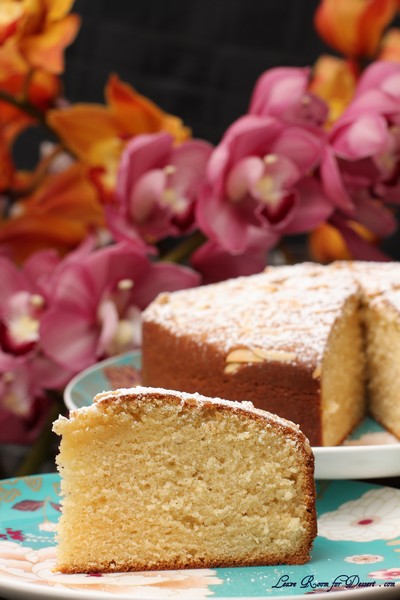
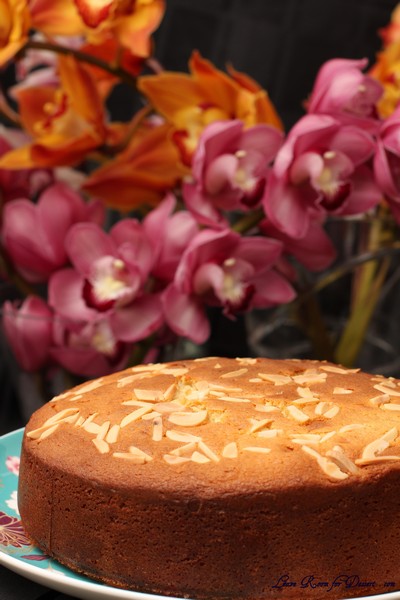

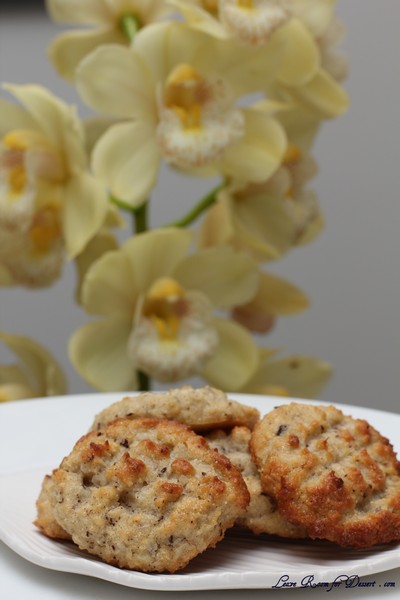
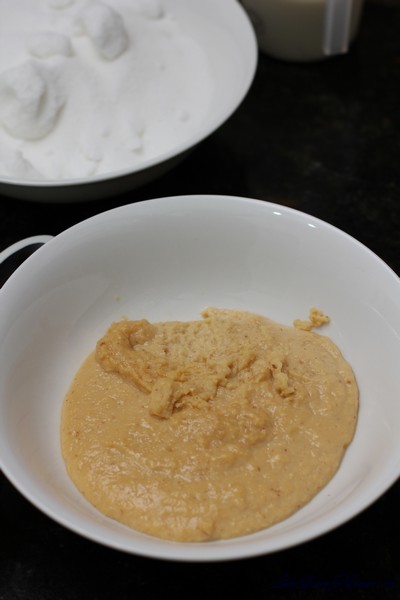
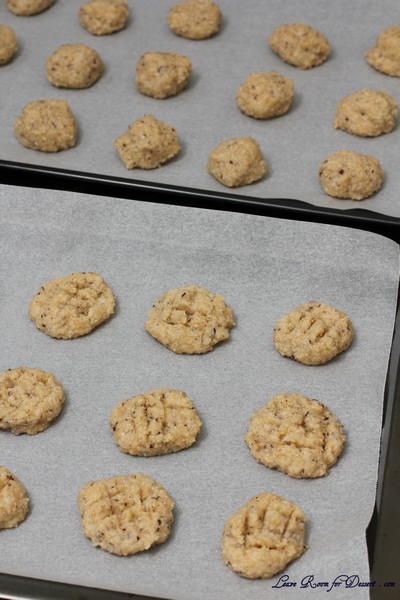
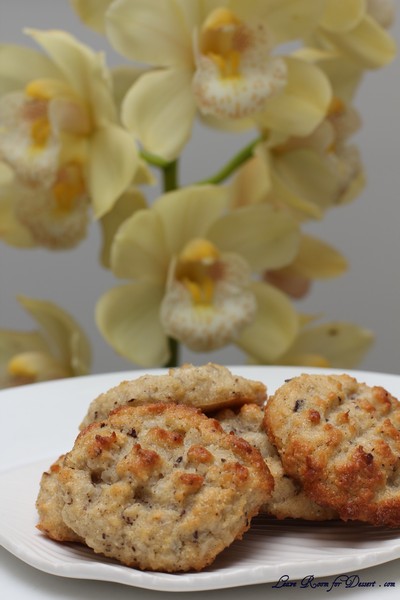


I was fortunate enough to have a couple of slices of this beautifully flavoured cake. It is a shame it takes so long to make the mawa component of this cake. Well done Anita, keep them coming!!!!
Great job! Both the cake and the cookies look wonderul.
I admire all those orchids in the background. They are so beautiful.